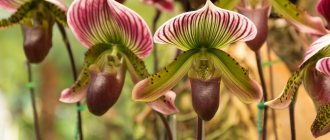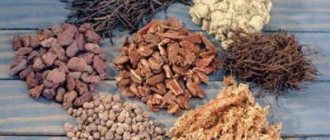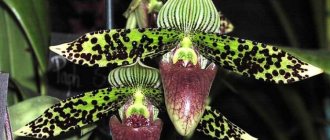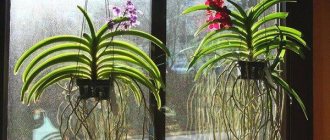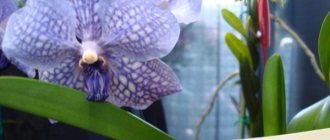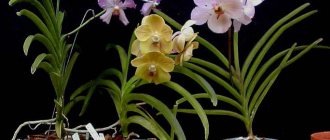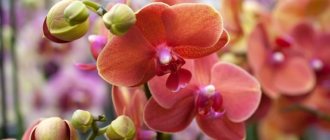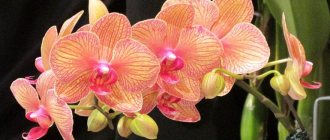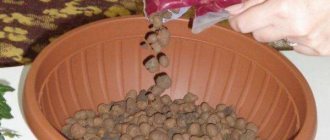This variety of orchid goes back to the 18th century in Asian countries. That's where she comes from.
In addition to its beautiful flowers, this orchid is unique for its root system : unlike other varieties, its roots are more powerful, they can receive moisture even from the atmosphere. Therefore, the Vanda orchid is not threatened by prolonged droughts and possible burns.
However, this variety is quite whimsical and will require great care during care . One slight mistake and the plant may die. Next we will tell you how to care for the beautiful Wanda.
Origin and description of the royal Vanda orchid
Vanda is a special genus of orchids and has 53 species. In nature, plants with bare hanging roots can be found in the tropics of Asia, Australia, and America. The species was first described by botanist William Johnson in 1795, the name being given is consonant with the Indian name of the plant - Vanda.
The central shoot is clearly expressed, there are no pseudobulbs. The growth point is apical. The solitary plant has a pronounced stem growing upward and often opposite leaves. In a tropical forest, an orchid can reach several meters in height. At home, the limit is 80 cm.
The Vanda orchid is an epiphyte, the distinctive feature of which is the aerial roots that hold the plant on the carrier. They are thick and powerful, covered with a layer of velamen, which allows them to absorb moisture from the environment. Under natural conditions, the root system can reach 2 m in length.
Vanda orchid is an epiphyte
The leaves are fleshy, cylindrical in shape, tightly adjacent to the stem. Peduncles emerge from the leaf axils, and from 1 to 4 arrows may appear simultaneously. The color of flowers is dominated by pink, blue and purple or a combination of these shades. The buds open gradually over 3 months.
Some species emit a pleasant aroma, but the plant has no place in the bedroom or children's room.
The royal flower is difficult to grow at home. He is more picky than other orchids. Wanda does not tolerate crowded spaces. The light should be diffused, the air moist and warm. But thanks to the persistence of breeders, new varieties are appearing that are quite compatible with simplified care.
If the plant has green roots, it means everything suits it.
Video: blue orchid
Description of varieties, including Vanda blue
- Vanda valvata - the stem is branched, the root system is powerful, the leaves are long and cylindrical. Up to 20 cm long. The flowers have pink petals, the lip is three-lobed, the middle part is purple, the side parts are yellow with specks and veins. The orchid blooms in October.
- Vanda blue is distinguished by belt-shaped leaves with teeth along the edge and obliquely cut at the end. On one peduncle there are up to 15 flowers, 10 cm in cross section. A blue flower with a small dark blue lip blooms in October. It has varieties with a lavender hue and a pattern resembling a mesh.
- Vanda tricolor grows up to 2 m in height, with a double crown of leaves. 7–10 flowers with a strong aroma are formed on the peduncle. Graceful side lobes frame the large lip. With good care, you can enjoy flowering twice a year - in winter and summer.
Photo gallery: which Wanda to choose
Vanda valvata has a long stem
Vanda blue flowers have a net pattern
Vanda tricolor exudes a strong aroma
Types of Vanda domestica orchid with photos and names
Blue Vanda (Vanda coerulea)
A popular variety of Vanda with strong, erect stems up to 1 meter high and hard, belt-shaped leaves about 15 cm long. Peduncles bear up to 20 large flowers of a pale blue hue with dark blue veins. There are also varieties with bright blue or pink petals covered with a dark, almost black network of veins.
Blue Vanda (Vanda coerulescens)
A miniature variety with long thin leaves collected in a rosette. On shortened peduncles there are small, but long-lived and very fragrant flowers of a soft blue hue. A distinctive feature of the variety is the lip, colored with blue markings.
Vanda Suarez or Vanda suaris
A large, abundantly flowering species, with long narrow dark green leaves and very beautiful flowers of unusual color: wavy milky-white petals and sepals are covered with a network of bright purple dots, spots and stripes, and the lip has a juicy pink tint.
Vanda cristata
A tall variety with very long, belt-shaped leaves and showy, fragrant flowers with narrow, ruffled yellow or blood-red petals and a large, soft lilac lip.
Vanda sanderiana
One of the most beautiful and unusual varieties of orchids. Its leaves are hard, long, with a forked tip. During the flowering period, large round flowers of a pale purple or pinkish hue bloom on the peduncles. The petals and lateral sepals are decorated with dark veins and a speckled pattern. Vanda Sandera also has an albino form, the flowers of which are greenish-white.
Vanda javierae
A very rare species of Vanda of compact size (no more than 35 cm in height) and unusual appearance. The inflorescences contain up to 8 small white flowers with a white lip, which at the very base is covered with many pale pink or brown markings.
Conditions for seasonal plant care
There are some seasonal patterns that ensure the existence of the species. In captivity, the plant will lose its decorative appearance, refuse to bloom and die if its needs are neglected. Vanda orchids are the most demanding in terms of maintenance conditions. When breeding at home, you should start with hybrid varieties; they are better adapted to indoor conditions.
How to care depending on the season and avoid sunburn - table
| Season | Lighting | Humidity | Temperature |
| Spring | Bright lighting is required, but the sun's rays must be avoided; their exposure causes burns on the leaves. Daylight hours are at least 12 hours. It is best to place it on western and eastern windows. The north window is not suitable. | Vanda requires high humidity - not lower than 80%, especially at elevated air temperatures. Spraying daily, and sometimes 2-3 times a day, will help avoid problems. Make sure that when moistening, water does not collect in the axils of the leaves. If the air temperature is below 18°C, do not spray the leaves. | Vanda is a heat-loving plant. Ideal conditions are achieved at 22 - 28°C. The maximum threshold can reach 40°C, and the minimum 8 - 10°C. The night temperature should differ from the day temperature; it should be lowered to 14°C. The orchid loves ventilated rooms, but it needs to be protected from drafts . |
| Summer | |||
| Autumn | In winter, you can place the plant on a south window. If Wanda remains on the east window, she will need additional lighting. | ||
| Winter |
Requirements for planting and transplanting
For planting, it is better to choose a plastic container with good drainage holes. In addition, the side walls should also have holes, which will improve root aeration. If you choose a ceramic pot, it should be poured, with smooth walls, which will make it easy to remove Vanda when replanting, and have holes at the bottom and sides. Wicker baskets or flowerpots are suitable.
To plant Vanda orchids you need to choose perforated pots
The plastic pot may not be transparent. But for a novice gardener, it is better to choose a transparent container; it is much easier to control the condition of the roots.
In specialized stores you can purchase ready-made substrate for orchids. When making your own mixture, use the following ingredients:
- old pine bark, boiled, dried and crushed;
- sphagnum moss;
- charcoal;
- coarse sand;
- crushed cork;
- To improve air and moisture permeability, you can add perlite.
The presence of drainage in the planting container is mandatory!
Healthy plants are replanted every 2–3 years, after flowering. The purchased Wanda must get used to the new conditions for a week before transplantation.
An emergency transplant is required if:
- the substrate has become compacted and the roots do not receive air;
- the moisture-intensive composition does not dry out for a long time;
- incorrect composition;
- the roots are too deep;
- The roots are rotting.
You can buy the substrate for planting or prepare it yourself
Step-by-step transplant
- Carefully remove Wanda from the old pot. If the roots are in the transport substrate, carefully remove it.
- Inspect the roots and rinse in warm water. Remove the damaged ones, and treat the cut areas or wounds with activated carbon.
- Place drainage in a new container and new soil mixture on top.
- Place the orchid in a new pot without damaging the roots. Add the rest of the mixture from the sides. Do not compact!
- If all the roots do not fit in the container, you can leave some outside.
- For the first 5 days, do not water, but only spray the leaves.
Most often, Vanda is grown not in a substrate, but with open roots - in baskets, lattice containers or on a piece of bark. In this case, it does not need replanting; attention should be paid to the root system, moisturizing and feeding it in time, as well as removing dried roots.
When growing Vanda in lattice containers, you need to pay more attention to the roots
How to grow roots on an orchid?
If an orchid does not grow roots, what should you do? Persistent and experienced gardeners not only use known methods to stimulate root growth in orchids. They will try new ones. And they themselves recommend that others do it. How not to take advantage of their advice!
Using cytokinin paste
Stimulation of root growth using cytokinin paste has been successfully used to awaken dormant buds on the peduncle. Both a new peduncle and a baby can grow from them. It is even carefully applied to the peduncle. And no more than in 3 places at the same time.
But flower growers do not recommend using it for orchid roots . There are other good remedies.
Using succinic acid
Succinic acid is quite accessible to many gardeners. Simple and effective:
- 4 tablets are enough per liter of water;
- Place the orchid above the water. 2-3 times a week its lower part is immersed in the solution;
- B vitamins are used in the same way. With their participation, a vitamin cocktail that has gained popularity is prepared;
- Lubricating the leaves with succinic acid gives good results. Both above and below. It is diluted in water and using a cotton swab wipe the leaves.
Succinic acid gives good results when growing roots.
Using root stimulants
Much is now written and talked about special preparations for stimulating root growth. Different opinions:
- For some they can even do the impossible;
- Others use them quite cautiously. And they are not very willing to tell you how to stimulate root growth with their help.
Some tips:
- Buy root formers in specialized stores. There is less risk of purchasing some kind of fake. It's a pity for the plant, the wasted time and effort. Not so much money;
- Follow the recommendations and instructions for use. Especially the dosage.
Radifarm
Italian drug. Plant extracts promote the development of the root system of many plants and stimulate their growth. How to grow new roots with it:
- One drop of the drug dissolves in one liter of water;
- Orchid roots should be soaked in the solution for 25-30 minutes.
Radifarm is successfully used for root growth.
Clonex-Gel (Clonex)
English drug in gel form:
- It is enough to dip the roots in the gel and place them on the prepared substrate (vermiculite, moss, perlite);
- It is more convenient to apply with a brush on the lower part;
- A layer of gel envelops the tissue and protects against infections;
Important! The packaging is quite impressive - 50 and 300 ml. Many people don't need that much. Even in Moscow it is packaged by hand. And they sell.
- Orchid lovers be careful. It is considered excellent for cuttings. Some of them did not succeed with orchids.
Kornevin
Refers to hormonal biological products . Kornevin includes:
- Heteroauxin;
- Manganese;
- Phosphorus;
- Potassium;
- Molybdenum.
How to prepare the required solution composition and apply:
- Dilute the required amount of powder in chilled boiled water. A 10 gram package is designed for 10 liters of water;
- Place the orchid roots in the prepared solution for 25-30 minutes;
- After removal, let it dry in a warm place for 12-15 hours;
- Place in a prepared greenhouse (or other container);
- Can also be used in combination with honey (sugar, molasses);
- Kornevin is also used in dry form. In combination with activated carbon and the addition of fungicides. They powder the cut areas.
Important! The solution cannot be stored. But the powder is preserved.
Using traditional methods
Other means may be offered to you:
- Ribav-extra;
- Embiko;
- Zircon.
Or you can use proven folk ones , without additional cash costs:
- Honey. One teaspoon is enough. Dissolve it in a liter of warm water. Keep the roots in this solution for an hour and a half to two hours. And again to normal Wednesday;
Honey can be used as fertilizer. - Some orchid lovers feed orchids with live beer .
Home care
The Vanda orchid requires special care.
Watering and fertilizing
Vanda needs good watering, but it can be somewhat unconventional. It all depends on the growing method.
- If the plant is grown in a substrate, watering is carried out 1–2 days after the substrate has almost completely dried. This prevents rotting of the root system.
- You can use the dipping method - lower the pot with the plant 1/3 into a bowl of water for 20–30 minutes. Then take it out and let the water drain.
- With an open root system, when the plant is in a hanging basket or on a piece of bark, moistening is carried out by soaking the roots, lowering them for 20 minutes in a container of water. This type of watering can be replaced with a good shower. It is important not to soak the leaves!
In winter, if the air temperature is low and the lighting is insufficient, Wanda can go without watering for almost a week.
Only the leaves need to be sprayed. The root system does not require such thorough hydration.
An aquarium, a tray with pebbles and wet moss, and a decorative fountain will also help to humidify the air.
Vanda needs high air humidity
Water for irrigation should be well settled and have a temperature of 30–50°C.
You can water orchids growing in soil mixture by dipping.
The Vanda orchid must be fertilized during the period of active growth. To do this, use a special balanced composition for orchids, which has the same ratio of phosphorus, nitrogen and potassium. The solution is diluted several times more than indicated. If the plant is cultivated without a substrate, the roots receive nutrition from the bath, where they are placed for 30 minutes, adding fertilizer to the water.
For better absorption of nutrients, it is recommended to alternate root and foliar feeding.
Features of growing in a glass flask
The Vanda orchid placed in a glass flask looks unusual. It is necessary to choose a vessel that is low, but wide at the base and tapering at the top. Only the roots are placed in it, the green part is located above the flask or vase. It is very convenient to care for a plant placed in this way.
Watering is carried out by dipping the roots into a container of water or filling the flask with liquid. In this case, the water should be poured out after 20 minutes.
If rotten roots appear, they should be removed
If rotten roots appear in the vase, they should be removed to avoid rot.
Growing Vanda in a tall cylindrical vase is not very convenient. The plant in it is in unnatural conditions, with folded leaves. Increased humidity will lead to the formation of a fungal infection that will damage the leaves and roots.
Growing Vanda in a tall glass flask is not very convenient
Flowering period
The first and main condition for the abundant flowering of Vanda is the love of the owner or mistress. In good conditions, an orchid can bloom several times a year. You need to spray Vanda very carefully during this period, trying to avoid getting water on the flowers - this will significantly shorten their flowering time.
The main reasons why Vanda does not bloom:
- there is not enough daylight hours, you need 14–16 hours;
- excess nitrogenous fertilizers;
- waterlogging of the substrate;
- the difference between day and night temperatures is not observed;
- cold content or presence of drafts.
If Wanda doesn’t want to bloom, then you need to give her a little shake-up and play with temperature changes during the crescent: up to 25°C during the day, and 10°C lower at night. Or limit watering. Choose a place that is lit, but shaded from direct sun. When a flower stalk appears, do not rush to flood the plant - continue to water carefully.
You should not combine both methods. You only need to choose one of them.
At the end of flowering, you need to wait for the peduncle to dry completely. After which it is cut at a height of 1 cm from the base.
Rest period
Royal orchids do not have a clear dormant period. But in winter, the temperature drops, watering and fertilizing become limited. At this time, you need to monitor the intensity and duration of lighting. If the roots remain green, the orchid is not dormant.
With a lack of light, the roots will begin to become covered with white skin. The sleeping beauty needs to be cheered up. To do this, you need to organize evening supplementary lighting until 22 hours. During the period when the roots do not work, the metabolism slows down, which is the time for infections to occur. Therefore, it is necessary to help the plant resume its growing season.
How to revive an orchid in greenhouse conditions?
If the gardener has a window greenhouse in which the plant will be kept at consistently high humidity and a comfortable temperature, there is a high probability of saving even a seriously weakened flower without a root system.
How to revive an orchid if the roots have rotted? In the container in which the flower is to be rooted:
- pour a thin layer of expanded clay;
- a layer of cleaned, thoroughly steamed sphagnum is placed on top of it.
The substrate is carefully moistened and a leaf rosette is placed in it. Until the plant develops roots 3–5 cm long, the flower will have to constantly be under cover:
- at air temperature from 22 to 28 °C;
- at air humidity within 70–100%;
- in bright diffused light for 12–14 hours a day.
Temperatures below 20 and above 33 °C inhibit root growth, but promote the proliferation of pathogenic flora and fungi.
What to do if all the roots of an orchid have rotted? Is it possible to stimulate root formation? Yes, this can be done with the help of proper care of the leaf rosette located in the greenhouse. As necessary, the substrate is slightly moistened and the greenhouse is ventilated. It is best to do this at night, which helps saturate the air with carbon dioxide and causes the rudiments of a future healthy root system to form faster.
Maintenance errors - table
| Error | Cause | Elimination |
| The leaves become dark green in color | Lack of light. | Move the plant to a more illuminated place or add additional light by turning on a fluorescent lamp. |
| The leaves are turning yellow |
|
|
| Leaves are soft and slightly wrinkled | Overwatering. | Follow the watering schedule. |
| Transparent spots on leaves | Sunburn. | If Wanda is in direct sun, she should be hidden behind a curtain. |
Optimal conditions of detention
The native habitats of orchids are tropical forests and mountains with abundant rainfall and long daily sunshine. But these beauties find places not under the scorching rays of the sun, but in shaded places .
It is not easy to create conditions such as in places where they naturally grow at home. But many lovers of original and amazing flowers successfully do this.
You can not only admire the numerous flowering species in the apartment, but also pay tribute to the flower growers who grow them and create various compositions.
Orchids grow well only in optimal conditions.
Only proper conditions of detention allow this to be achieved:
- Well lit places. Considering the type of orchid: But none of them like direct sunlight. They are even dangerous for them;
- Increasingly, gardeners are equipping additional lighting. This allows you to place plants regardless of windows. And do not depend on the time of year;
- Various phytolamps are especially effective.
Orchids need to be watered very carefully.
Diseases and pests - table
| Diseases and pests | Symptoms | Prevention | Control measures |
| Fusarium | Dark spots appear at the base of the leaves. The leaves are falling off. |
|
|
| Shchitovka | Convex brown tubercles in the axils of the leaves are scale insects. The pest feeds on the sap of the plant, causing the leaves to turn yellow and dry out. |
|
|
| Aphid | Small insects very quickly create entire colonies on the affected plant. Due to their activity, the leaves die. |
|
How to recognize pests and diseases - photo
Orchid infected with fusarium
Scale insects on orchid leaves
Aphids greatly weaken the plant
Pests and diseases
Diseases
Due to being kept in conditions with high humidity, Wanda is not resistant to the following diseases.
Fusarium
A fungal disease that affects the blood vessels of a plant. It begins with a change in color of the lower leaves, which become yellow or orange.
- Causes of infection:
- excess moisture;
- high soil temperature;
- pest damage.
- Treatment:
- remove affected parts;
- treat the roots and leaves with Fitoflavin, Fitoverm, Fitosporin, Vectra or Vitaros in accordance with the instructions.
Fomoz (dry rot)
A disease caused by pathogenic fungi, the mycelium of which multiplies mainly on the surface of the plant, but in rare cases also affects the root system.
The leaf plates are affected first, then the stem. Appears as brown or black spots. As the disease progresses, voids form in the stem, which leads to their breaking off, and the roots become covered with weeping sores.
- Causes of infection:
- high humidity (more than 85-90%);
- high ambient temperature (above +300C).
- Treatment:
- remove affected parts;
- treat the orchid with Bordeaux mixture or Fitosporin - M in accordance with the instructions;
- replace the soil mixture.
Pests
The orchid is susceptible to pest damage:
- Thrips are small insects that feed on plant sap. They are destroyed by biological preparations Fitoverm and Leptotsid.
- Aphids are insects up to 2 mm in size that attack leaves and stems. They die when sprayed with biological preparations Fitoverm, Biostop or Leptotsid.
- Scale insects are insects, up to 3 mm long, with a hard coating.
They reproduce quickly and feed on sap. They secrete a sticky liquid in which rot develops. They do not die when sprayed. They are destroyed only with chemical preparations Aktara or Actellik, diluted according to the instructions. Treatment is carried out by soaking the roots in the solution for 10-20 minutes.
Reanimation of a dying orchid without roots
It happens that a favorite flower dies - the roots are rotten, the top is limp. To save, you can try several methods.
Remove any bad roots and hang the plant upside down in the shade. The plant tends to grow upward, so let new roots grow upward. You need to take the fertilizer recommended for orchids, add sugar and dissolve it in distilled water in the indicated dose. Spray Vanda thoroughly every day. The water will drain, and feeding with glucose will help keep the leaves alive. After 2–3 months, the roots will grow. When they grow 5–7 cm, plant the plant in a pot.
The second method is less extreme, but also helps to save the orchid:
- Remove Wanda from the substrate. Remove all rotten roots.
- Wash the base in a fungicide solution heated to 30°C and dry.
- Then soak for 10 minutes in a growth stimulator, for example, Kornevin.
- Pour half the volume of drainage into a transparent container and moisten it.
- Place a layer of moss on top and also moisten thoroughly.
- Make a small depression in the middle and place Vanda in it, covering the sides with the remaining moss.
- Place the container with the orchid in a well-ventilated and warm room.
- Moisten the moss only along the edges.
- After a month, a new root system will form and the plant can be transplanted into a pot.
How to save an orchid with rotten roots?
Having noticed that recently a living and healthy flower has become lethargic, the leaves have lost their juiciness, withered, and even watering does not help the plant recover, the gardener should be wary. The sooner the problem is discovered, the easier it will be to resuscitate the orchid, because without roots the flower will not be able to feed and will inevitably die.
Before resuscitating an orchid at home, you need to assess the situation and find out the extent of the damage. This is done by carefully examining the root system:
- Living and healthy roots are always dense, with an elastic, uniform surface. The younger the rhizomes, the lighter their color, and when immersed in water or after abundant irrigation they become noticeably greener.
- Old rhizomes have a gray or brownish tint. But as long as they feed the leaf rosette and peduncles, the roots remain hard, smooth and dry to the touch.
Removing the substrate and washing the underground part of the plant will show a complete picture of the damage. A sign of rotting, bacterial or fungal infection is:
- darkening of rhizomes;
- the appearance of wet, slimy areas on them;
- flow of water when you press on the root;
- thread-like appearance of collapsed roots.
Unfortunately, rotten roots can no longer be saved, so they are removed, carefully trimmed to healthy tissue. Do the same with dried rhizomes. The loss of two or three roots, if the plant is properly cared for, will not affect its viability.
But what to do if all or most of the orchid’s roots have rotted? Is it possible to restore health to the plant or will you have to say goodbye to the green pet?
After removing the problem areas, the cuts on the remaining parts must be treated with activated carbon crushed to the powder stage or ground cinnamon, which also has pronounced disinfectant properties. When the roots dry, it is useful to immerse them in a fungicide solution for 10–15 minutes. This will reduce the risk of colonizing a weakened plant with harmful fungi.
Having disinfected the remaining roots and ensured the protection of the plant, it is important to treat the growth area of future roots with a growth stimulator. This will strengthen the orchid’s immunity and speed up rooting.
Vanda orchid propagation
Vanda can only be propagated at home by vegetative means. Propagation by seeds is very labor-intensive and is used only in laboratories.
Using apical cuttings
In an adult plant, more and more aerial roots appear in the leaf axils.
- Cut off the top with 2-4 roots.
- Pour the bark into the pot and moisten it.
- We make a small depression in the center and insert the top into it, having previously treated the cut area with charcoal or cinnamon.
- We place the pot in a warm place, but not too sunny.
- Water only after the substrate has completely dried. Spray carefully so that water does not accumulate in the axils of the leaves.
Reproduction
Like all other types of orchids, Vanda reproduces by transplanting its children . This phenomenon is quite rare; they can be separated from the main root system when the child’s roots reach a length of at least 5 cm . After circumcision of the baby, the place of attachment to the roots must be treated with charcoal to prevent the spread of infection.
Orchid Vanda (photo with baby).
The baby is placed in a special pot and kept in greenhouse conditions, while the air humidity should be about 90%. Tree bark and sphagnum moss (4:1) are used as a substrate. In this way, the baby is kept until it grows 20 cm in length, then it can be transplanted into a regular orchid pot and continued care as for an adult plant.
It should be noted that any other methods of transplanting this plant are prohibited . However, diligent flower growers sometimes try to propagate Vanda using seeds. This is a very long and labor-intensive process.
Features of the process, how to grow from a seed:
- seeds are grown in a nutrient medium, which is obtained under sterile laboratory conditions;
- germination duration is about 9 months;
- it takes up to 3 years to get a shoot that can be transplanted;
- Flowering of a plant grown in this way can take up to 4-10 years.
For propagation, therefore, you will need Vanda orchid seeds, moist soil (moss and deciduous soil), conditions of complete sterility, temperature within 25 degrees, humidity - 80-90%. After the first leaves appear, they need to be picked.
